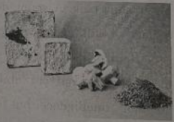
In a world where fire threatens more and more homes, scientists have developed a surprising type of material that might keep some buildings safer: thin sheets of fungi(真菌).
Underneath every mushroom is a branching network of root like structures called a mycelium(菌丝体). Now researchers have successfully grown these networks into pizza-size sheets that could act as a fire retardant in building materials, according to a new study in Polymer Degradation and Stability.
"Using a biological material like mycelium has enormous benefits", says senior author Everson Kandare. Unlike asbestos, which is still sometimes added to building materials as a fire retardant, mycelium does not release poisonous compounds when exposed to fire. "When there is a building fire, it often isn't the flame intensity or the heat that kills or injures people," says Kandare, an engineer at RMIT University in Melbourne, Australia. "It is the smoke and the poisonous metal that comes out of building materials."
The new mycelium sheets, grown into protective carpets up to a few millimeters thick, could prevent such building materials from burning in the first place. Mycelium contains a lot of carbon. When exposed to fire, the sheet briefly burns, releasing water and carbon dioxide into the air, leaving behind a black layer of carbon.
This study is the first to integrate these properties into a useful building material. Kandare suggests mycelium could replace the fire retardant foam(泡沫剂), which can produce CO and other poisonous products when it burns.
The RMIT team has been reaching out to mushroom farmers to see whether they could promote the technology for commercial use. Kandare says, "Mycelium can grow in the dark, which means its energy needs are relatively minimal. Even better, mycelium is a biological material, and any waste it leaves behind can be used as fertilizer."
